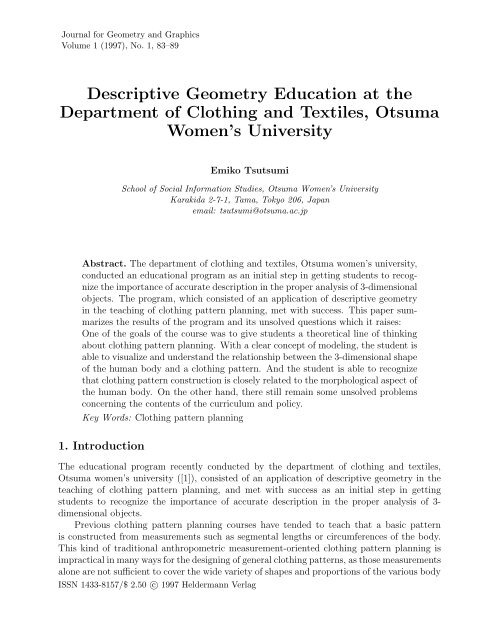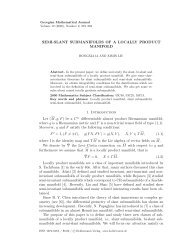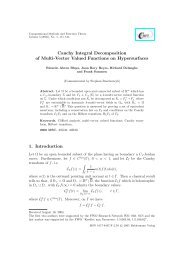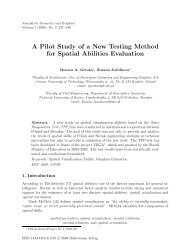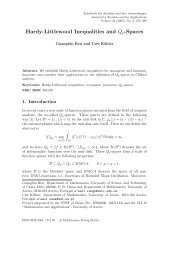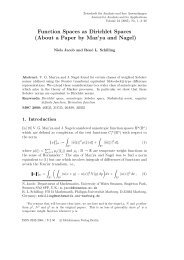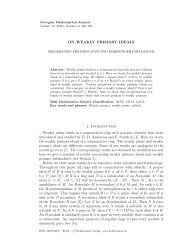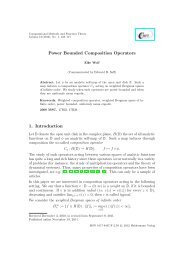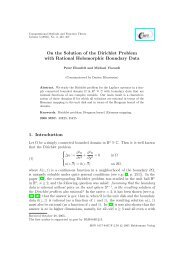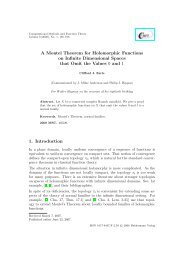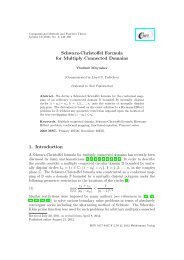Descriptive Geometry Education at the Department of Clothing and ...
Descriptive Geometry Education at the Department of Clothing and ...
Descriptive Geometry Education at the Department of Clothing and ...
You also want an ePaper? Increase the reach of your titles
YUMPU automatically turns print PDFs into web optimized ePapers that Google loves.
Journal for <strong>Geometry</strong> <strong>and</strong> Graphics<br />
Volume 1 (1997), No. 1, 83–89<br />
<strong>Descriptive</strong> <strong>Geometry</strong> <strong>Educ<strong>at</strong>ion</strong> <strong>at</strong> <strong>the</strong><br />
<strong>Department</strong> <strong>of</strong> <strong>Clothing</strong> <strong>and</strong> Textiles, Otsuma<br />
Women’s University<br />
Emiko Tsutsumi<br />
School <strong>of</strong> Social Inform<strong>at</strong>ion Studies, Otsuma Women’s University<br />
Karakida 2-7-1, Tama, Tokyo 206, Japan<br />
email: tsutsumi@otsuma.ac.jp<br />
Abstract. The department <strong>of</strong> clothing <strong>and</strong> textiles, Otsuma women’s university,<br />
conducted an educ<strong>at</strong>ional program as an initial step in getting students to recognize<br />
<strong>the</strong> importance <strong>of</strong> accur<strong>at</strong>e description in <strong>the</strong> proper analysis <strong>of</strong> 3-dimensional<br />
objects. The program, which consisted <strong>of</strong> an applic<strong>at</strong>ion <strong>of</strong> descriptive geometry<br />
in <strong>the</strong> teaching <strong>of</strong> clothing p<strong>at</strong>tern planning, met with success. This paper summarizes<br />
<strong>the</strong> results <strong>of</strong> <strong>the</strong> program <strong>and</strong> its unsolved questions which it raises:<br />
One <strong>of</strong> <strong>the</strong> goals <strong>of</strong> <strong>the</strong> course was to give students a <strong>the</strong>oretical line <strong>of</strong> thinking<br />
about clothing p<strong>at</strong>tern planning. With a clear concept <strong>of</strong> modeling, <strong>the</strong> student is<br />
able to visualize <strong>and</strong> underst<strong>and</strong> <strong>the</strong> rel<strong>at</strong>ionship between <strong>the</strong> 3-dimensional shape<br />
<strong>of</strong> <strong>the</strong> human body <strong>and</strong> a clothing p<strong>at</strong>tern. And <strong>the</strong> student is able to recognize<br />
th<strong>at</strong> clothing p<strong>at</strong>tern construction is closely rel<strong>at</strong>ed to <strong>the</strong> morphological aspect <strong>of</strong><br />
<strong>the</strong> human body. On <strong>the</strong> o<strong>the</strong>r h<strong>and</strong>, <strong>the</strong>re still remain some unsolved problems<br />
concerning <strong>the</strong> contents <strong>of</strong> <strong>the</strong> curriculum <strong>and</strong> policy.<br />
Key Words: <strong>Clothing</strong> p<strong>at</strong>tern planning<br />
1. Introduction<br />
The educ<strong>at</strong>ional program recently conducted by <strong>the</strong> department <strong>of</strong> clothing <strong>and</strong> textiles,<br />
Otsuma women’s university ([1]), consisted <strong>of</strong> an applic<strong>at</strong>ion <strong>of</strong> descriptive geometry in <strong>the</strong><br />
teaching <strong>of</strong> clothing p<strong>at</strong>tern planning, <strong>and</strong> met with success as an initial step in getting<br />
students to recognize <strong>the</strong> importance <strong>of</strong> accur<strong>at</strong>e description in <strong>the</strong> proper analysis <strong>of</strong> 3-<br />
dimensional objects.<br />
Previous clothing p<strong>at</strong>tern planning courses have tended to teach th<strong>at</strong> a basic p<strong>at</strong>tern<br />
is constructed from measurements such as segmental lengths or circumferences <strong>of</strong> <strong>the</strong> body.<br />
This kind <strong>of</strong> traditional anthropometric measurement-oriented clothing p<strong>at</strong>tern planning is<br />
impractical in many ways for <strong>the</strong> designing <strong>of</strong> general clothing p<strong>at</strong>terns, as those measurements<br />
alone are not sufficient to cover <strong>the</strong> wide variety <strong>of</strong> shapes <strong>and</strong> proportions <strong>of</strong> <strong>the</strong> various body<br />
ISSN 1433-8157/$ 2.50 c○ 1997 Heldermann Verlag
84 E. Tsutsumi: <strong>Descriptive</strong> <strong>Geometry</strong> <strong>Educ<strong>at</strong>ion</strong> <strong>at</strong> Otsuma Women’s University<br />
Figure 1: Orthogonal projection<br />
Figure 2: Intersection: a) Trunk <strong>and</strong> upper arm b) Trunk <strong>and</strong> neck<br />
types. Analyses <strong>of</strong> both measurements <strong>and</strong> figure <strong>of</strong> <strong>the</strong> human body are required in <strong>the</strong> study<br />
<strong>of</strong> <strong>the</strong> clothing p<strong>at</strong>tern planning.<br />
In this paper we discuss <strong>the</strong> major role <strong>of</strong> descriptive geometry embedded in clothing<br />
p<strong>at</strong>tern planning <strong>and</strong> its unsolved points.<br />
2. Course Contents <strong>and</strong> Teaching Method<br />
2.1. Contents<br />
<strong>Descriptive</strong> geometry for clothing p<strong>at</strong>tern planning is a semiannual elective subject for students<br />
in <strong>the</strong>ir third year <strong>and</strong> consists <strong>of</strong> lecture <strong>and</strong> practical training. The main goal <strong>of</strong> <strong>the</strong><br />
course is to enhance <strong>the</strong> visualiz<strong>at</strong>ion abilities <strong>of</strong> <strong>the</strong> students <strong>and</strong> to have <strong>the</strong>m recognize <strong>the</strong><br />
importance <strong>of</strong> accur<strong>at</strong>e description in <strong>the</strong> proper analysis <strong>of</strong> <strong>the</strong> 3-dimensional objects, i.e.,<br />
human body <strong>and</strong> <strong>the</strong> clo<strong>the</strong>s having on <strong>the</strong> body. The contents <strong>of</strong> <strong>the</strong> course are as follows:<br />
1. Detailed observ<strong>at</strong>ions <strong>and</strong> accur<strong>at</strong>e descriptions <strong>of</strong> 3-dimensional objects through orthogonal<br />
projection.<br />
2. Drawings <strong>of</strong> intersections <strong>and</strong> <strong>the</strong>ir development using two regular solids such as prisms
E. Tsutsumi: <strong>Descriptive</strong> <strong>Geometry</strong> <strong>Educ<strong>at</strong>ion</strong> <strong>at</strong> Otsuma Women’s University 85<br />
Figure 3: Cross-sections <strong>of</strong> a human body<br />
or pyramids ei<strong>the</strong>r <strong>of</strong> which have been modeled after human figures.<br />
3. D<strong>at</strong>a h<strong>and</strong>ling <strong>and</strong> analysis <strong>of</strong> <strong>the</strong> characteristics <strong>and</strong> approxim<strong>at</strong>e surface development<br />
<strong>of</strong> a human body figure both <strong>of</strong> which are taken from 3-dimensional measurements <strong>of</strong><br />
actual human bodies.<br />
2.2. Teaching Methods<br />
The first section <strong>of</strong> <strong>the</strong> content consists <strong>of</strong> having students acquire some projection methods,<br />
especially orthogonal projection <strong>and</strong> including auxiliary projection (Fig. 1). Every particip<strong>at</strong>ing<br />
student is provided with a paper model <strong>of</strong> a gable-ro<strong>of</strong>ed house <strong>and</strong> is required to<br />
make drawings <strong>of</strong> <strong>the</strong> principal views <strong>of</strong> this <strong>and</strong> also to imagine <strong>and</strong> sketch several projected<br />
figures <strong>of</strong> <strong>the</strong> paper model, i.e., auxiliary projections. After having made drawings <strong>of</strong> real<br />
auxiliary projections, <strong>the</strong> student is required to ascertain <strong>the</strong> sketches. It is here th<strong>at</strong> <strong>the</strong><br />
student learns to recognize <strong>the</strong> rel<strong>at</strong>ionship between 3-dimensional shapes <strong>and</strong> <strong>the</strong>ir accur<strong>at</strong>e<br />
projected figures.<br />
The second section <strong>of</strong> <strong>the</strong> contents is directed <strong>at</strong> <strong>the</strong> h<strong>and</strong>ling <strong>of</strong> <strong>the</strong> intersection <strong>of</strong> two<br />
geometrical shapes which have been modeled from two adjacent human body segments, such<br />
as a trunk <strong>and</strong> upper arm or a neck <strong>and</strong> trunk (Fig. 2). This modeling makes it possible for<br />
<strong>the</strong> student to define <strong>and</strong> h<strong>and</strong>le a rel<strong>at</strong>ion between <strong>the</strong> paired segments clearly <strong>and</strong> easily. If,<br />
in place <strong>of</strong> <strong>the</strong> model, <strong>the</strong>re is a human body wearing tight clo<strong>the</strong>s, <strong>the</strong> surface developments<br />
are considered to be <strong>the</strong> basic p<strong>at</strong>terns <strong>of</strong> <strong>the</strong> clo<strong>the</strong>s, i.e., <strong>the</strong> body <strong>and</strong> a sleeve or <strong>the</strong> body<br />
<strong>and</strong> <strong>the</strong> collar. In this way, students gain <strong>the</strong> ability to h<strong>and</strong>le clothing p<strong>at</strong>terns using a<br />
geometrical model.<br />
In <strong>the</strong> third section <strong>of</strong> <strong>the</strong> contents, students are given layered cross-sections <strong>of</strong> an existing<br />
human body (Fig. 3a). The purpose <strong>of</strong> <strong>the</strong> exercise is to learn how <strong>the</strong> human figure should be<br />
modeled <strong>and</strong> developed. Although it is impossible to exp<strong>and</strong> a complex curved surface such as<br />
th<strong>at</strong> <strong>of</strong> a human body onto a plane surface, it is possible to develop it approxim<strong>at</strong>ely, if each<br />
segmental body surface enclosed by two adjacent cross sections is considered to be a warped<br />
cone (Figures 3b <strong>and</strong> 4a). The carefully approxim<strong>at</strong>ed surface development is regarded as
86 E. Tsutsumi: <strong>Descriptive</strong> <strong>Geometry</strong> <strong>Educ<strong>at</strong>ion</strong> <strong>at</strong> Otsuma Women’s University<br />
Figure 4: Surface development <strong>of</strong> right half <strong>of</strong> upper trunk<br />
Figure 5: Approxim<strong>at</strong>ed surface development <strong>of</strong> different body figure<br />
<strong>the</strong> fundamental figure <strong>of</strong> <strong>the</strong> basic clothing p<strong>at</strong>tern <strong>of</strong> <strong>the</strong> body (Fig. 4b). Thus <strong>the</strong> students<br />
are required to analyze rel<strong>at</strong>ionships between various shape characteristics <strong>of</strong> a human body<br />
model such as posture, body build, motion, etc., <strong>and</strong> its surface development (Fig. 5). In<br />
<strong>the</strong> final exercise, <strong>the</strong> students construct <strong>and</strong> make observ<strong>at</strong>ions <strong>of</strong> a paper-model <strong>of</strong> a human<br />
trunk using <strong>the</strong> surface development <strong>and</strong> <strong>the</strong> cross-sections.<br />
3. Results<br />
3.1. Results <strong>of</strong> <strong>the</strong> Teaching in <strong>the</strong> Course<br />
In <strong>the</strong> first section <strong>of</strong> <strong>the</strong> contents, <strong>the</strong> students experienced some difficulty in recognizing<br />
parallel projection. Some students were unable to perceive <strong>the</strong> edge view as a straight line<br />
(Fig. 6). They drew <strong>the</strong> edge view as if <strong>the</strong>y have been observing an oblique plain. Some <strong>of</strong><br />
<strong>the</strong>m sketched <strong>the</strong> paper-model house using perspective projection. Wh<strong>at</strong>ever <strong>the</strong>se results<br />
actually mean, it is certain th<strong>at</strong> <strong>the</strong> exercise gave students <strong>the</strong> opportunity to observe <strong>the</strong>
E. Tsutsumi: <strong>Descriptive</strong> <strong>Geometry</strong> <strong>Educ<strong>at</strong>ion</strong> <strong>at</strong> Otsuma Women’s University 87<br />
characteristics <strong>of</strong> parallel projection after having taken a paper-model in <strong>the</strong>ir own h<strong>and</strong>s <strong>and</strong><br />
having made a thorough investig<strong>at</strong>ion from all angles, from near <strong>and</strong> from far.<br />
Figure 6: Sketch <strong>of</strong> projections <strong>of</strong> <strong>the</strong> paper model <strong>of</strong> <strong>the</strong> gable-ro<strong>of</strong>ed house<br />
One <strong>of</strong> <strong>the</strong> exercises requires to draw <strong>the</strong> intersection <strong>and</strong> <strong>the</strong> surface development <strong>of</strong> two<br />
cylinders. It is supposed th<strong>at</strong> <strong>the</strong> large cylinder is a human trunk <strong>and</strong> <strong>the</strong> o<strong>the</strong>r smaller one<br />
an upper arm. In this exercise, students change <strong>the</strong> arrangement <strong>of</strong> <strong>the</strong> smaller cylinder in<br />
order to represent <strong>the</strong> motion <strong>of</strong> <strong>the</strong> upper arm (Fig. 7). The differences which appear on<br />
<strong>the</strong> surface development <strong>of</strong> <strong>the</strong> cylinder as it goes through <strong>the</strong> various positions called for in<br />
<strong>the</strong> exercise, gets <strong>the</strong> students to notice th<strong>at</strong> <strong>the</strong> motion <strong>of</strong> a segment <strong>of</strong> <strong>the</strong> human body<br />
brings about a new phase in <strong>the</strong> development, i.e., <strong>the</strong> clothing p<strong>at</strong>tern (Fig. 7b). In this way,<br />
students recognize th<strong>at</strong> separ<strong>at</strong>e clothing p<strong>at</strong>terns exist according to various functions, as it<br />
is shown in Fig. 7:<br />
c) A woman wearing a formal dress, being modestly, is apt to keep her upper arm in st<strong>at</strong>ic<br />
position.<br />
d) A woman wearing working clo<strong>the</strong>s is <strong>the</strong> most ready to raise <strong>and</strong> lower her arm during<br />
working.<br />
Here variety may be induced into <strong>the</strong> clothing p<strong>at</strong>tern not only by <strong>the</strong> motion <strong>of</strong> <strong>the</strong> body<br />
but also by <strong>the</strong> size <strong>and</strong> proportional vari<strong>at</strong>ion <strong>of</strong> <strong>the</strong> segments.<br />
Concerning <strong>the</strong> third section <strong>of</strong> <strong>the</strong> contents, <strong>the</strong> drawings <strong>of</strong> <strong>the</strong> warped cone <strong>and</strong> its<br />
surface development were r<strong>at</strong>her complic<strong>at</strong>ed for <strong>the</strong> students, for <strong>the</strong> reason th<strong>at</strong> it was<br />
difficult for <strong>the</strong>m to arrange elements lines taking care to keep in shape (Fig. 3b). However,<br />
<strong>the</strong> process <strong>of</strong> approxim<strong>at</strong>ion was a useful one for <strong>the</strong>m in th<strong>at</strong> it enabled <strong>the</strong>m to grasp <strong>the</strong><br />
concept <strong>of</strong> <strong>the</strong> unevenness <strong>of</strong> <strong>the</strong> body surface. In this way, <strong>the</strong> students came to realize th<strong>at</strong><br />
an investig<strong>at</strong>ion <strong>of</strong> <strong>the</strong> rel<strong>at</strong>ionship between various kinds <strong>of</strong> simply approxim<strong>at</strong>ed models <strong>of</strong><br />
human figures <strong>and</strong> <strong>the</strong>ir surface developments gave <strong>the</strong>m better grasp <strong>of</strong> <strong>the</strong> kind <strong>of</strong> process
88 E. Tsutsumi: <strong>Descriptive</strong> <strong>Geometry</strong> <strong>Educ<strong>at</strong>ion</strong> <strong>at</strong> Otsuma Women’s University<br />
Figure 7: Intersection <strong>and</strong> development <strong>of</strong> Arm Model<br />
required for a well-planned basic clothing p<strong>at</strong>tern.<br />
3.2. The Role <strong>of</strong> <strong>Descriptive</strong> <strong>Geometry</strong> in <strong>the</strong> Course<br />
The overall purpose <strong>of</strong> <strong>the</strong> course was to enhance <strong>the</strong> visualiz<strong>at</strong>ion abilities <strong>of</strong> <strong>the</strong> students <strong>and</strong><br />
to have <strong>the</strong>m recognize <strong>the</strong> importance <strong>of</strong> proper analysis <strong>of</strong> 3-dimensional objects through<br />
accur<strong>at</strong>e descriptions. The results, on <strong>the</strong> whole, showed th<strong>at</strong> descriptive geometry plays an<br />
important part in getting students to underst<strong>and</strong> clothing p<strong>at</strong>tern planning from <strong>the</strong> viewpoint<br />
<strong>of</strong> human engineering <strong>and</strong> also in getting <strong>the</strong>m to realize th<strong>at</strong> clothing p<strong>at</strong>tern construction<br />
is closely rel<strong>at</strong>ed to <strong>the</strong> morphological aspect <strong>of</strong> <strong>the</strong> human body. Proper analyses <strong>of</strong> <strong>the</strong><br />
rel<strong>at</strong>ionship between human figures <strong>and</strong> <strong>the</strong>ir clothing p<strong>at</strong>terns were accomplished merely by<br />
using simple approxim<strong>at</strong>ed segmental models to furnish a description <strong>of</strong> <strong>the</strong> human body.<br />
And from <strong>the</strong> construction <strong>and</strong> subsequent observ<strong>at</strong>ion <strong>of</strong> a paper-model <strong>of</strong> <strong>the</strong> human trunk<br />
using <strong>the</strong> approxim<strong>at</strong>ed surface development <strong>and</strong> cross sectional inform<strong>at</strong>ion, <strong>the</strong> students<br />
gained <strong>the</strong> ability to recognize sp<strong>at</strong>ial inform<strong>at</strong>ion as an actual entity.
E. Tsutsumi: <strong>Descriptive</strong> <strong>Geometry</strong> <strong>Educ<strong>at</strong>ion</strong> <strong>at</strong> Otsuma Women’s University 89<br />
4. The Unsolved Points <strong>of</strong> <strong>the</strong> Course<br />
After having pointed out several merits <strong>of</strong> <strong>the</strong> course, it must also be said th<strong>at</strong> <strong>the</strong>re were some<br />
difficulties in <strong>the</strong> course arrangement. First it is expected for <strong>the</strong> students in <strong>the</strong> course to<br />
study multifarious leanings, because <strong>the</strong>re is almost no o<strong>the</strong>r subject in <strong>the</strong> curriculum which<br />
is so relevant to <strong>the</strong> description <strong>and</strong> analysis <strong>of</strong> body shape <strong>and</strong> clothing p<strong>at</strong>terns except<br />
for practical training for draping, i.e., p<strong>at</strong>tern making using lay figures <strong>and</strong> cloth. Even in<br />
draping training, recognition <strong>of</strong> <strong>the</strong> body as a 3-dimensional structure is an important m<strong>at</strong>ter.<br />
Wh<strong>at</strong> should be emphasized within a descriptive geometry curriculum for students who are<br />
majoring in clothing <strong>and</strong> textiles has yet to be established. And <strong>the</strong> question remains how<br />
we can train or improve <strong>the</strong> student’s concept <strong>of</strong> sp<strong>at</strong>ial abilities.<br />
Although <strong>the</strong> goal <strong>of</strong> <strong>the</strong> course is to teach <strong>the</strong> students <strong>the</strong> fundamentals <strong>of</strong> clothing<br />
p<strong>at</strong>tern planning through an applic<strong>at</strong>ion <strong>of</strong> descriptive geometry to <strong>the</strong> 3-dimensional shape<br />
<strong>of</strong> <strong>the</strong> human body, it is also important to know how p<strong>at</strong>tern making is carried out in industry.<br />
Factory visits or lectures by speakers from <strong>the</strong> industry are recommended as <strong>the</strong>y would<br />
undoubtedly rouse students’ interest in clothing p<strong>at</strong>tern planning. From this point <strong>of</strong> view<br />
also, p<strong>at</strong>tern making training using a computer aided design system along with computer<br />
graphics might be indic<strong>at</strong>ed.<br />
5. Summary <strong>and</strong> Conclusion<br />
The educ<strong>at</strong>ional program conducted by <strong>the</strong> department <strong>of</strong> clothing <strong>and</strong> textiles, Otsuma<br />
women’s university, met with success as an initial step in getting students to recognize <strong>the</strong><br />
importance <strong>of</strong> accur<strong>at</strong>e description in <strong>the</strong> proper analysis <strong>of</strong> <strong>the</strong> 3-dimensional object. With a<br />
clear concept <strong>of</strong> modeling, <strong>the</strong> students were able to visualize <strong>and</strong> underst<strong>and</strong> <strong>the</strong> rel<strong>at</strong>ionship<br />
between <strong>the</strong> 3-dimensional shape <strong>of</strong> <strong>the</strong> human body <strong>and</strong> clothing p<strong>at</strong>terns, <strong>and</strong> were able to<br />
recognize th<strong>at</strong> clothing p<strong>at</strong>tern construction is closely rel<strong>at</strong>ed to <strong>the</strong> morphological aspect <strong>of</strong><br />
<strong>the</strong> human body. The course was considered to give students a <strong>the</strong>oretical line <strong>of</strong> thinking<br />
about clothing p<strong>at</strong>tern planning. On <strong>the</strong> neg<strong>at</strong>ive side, however, some questions still remain.<br />
Wh<strong>at</strong> content should be carried over from descriptive geometry curriculum which is basically<br />
engineering in order to provide a more in-depth study <strong>of</strong> clothing p<strong>at</strong>tern planning? How<br />
is it possible to broaden students’ outlook for general clothing p<strong>at</strong>tern planning? Here <strong>the</strong><br />
intention is to construct an educ<strong>at</strong>ional program th<strong>at</strong> will build a closer connection with<br />
industry while <strong>at</strong> <strong>the</strong> same time giving a good grounding in clothing p<strong>at</strong>tern planning.<br />
Acknowledgment<br />
The author would like to acknowledge <strong>the</strong> continuing guidance <strong>and</strong> encouragement by Dr.<br />
H. Isoda, Pr<strong>of</strong>essor emeritus <strong>at</strong> <strong>the</strong> University <strong>of</strong> Tokyo, <strong>and</strong> Dr. K. Suzuki, Pr<strong>of</strong>essor <strong>at</strong> <strong>the</strong><br />
University <strong>of</strong> Tokyo.<br />
References<br />
[1] E. Tsutsumi: Teaching <strong>Descriptive</strong> <strong>Geometry</strong> in <strong>Clothing</strong> P<strong>at</strong>tern Planning. Proceedings<br />
<strong>of</strong> <strong>the</strong> 1st China-Japan Joint Intern<strong>at</strong>ional Conference on Graphics <strong>Educ<strong>at</strong>ion</strong>, Wuxi<br />
1993, p. 139-144.<br />
Received November 26, 1996; final form May 6, 1997


